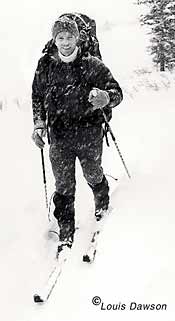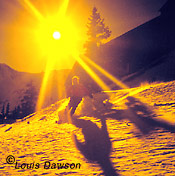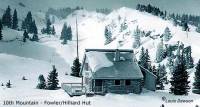
Ski touring on classic gear at the Colorado huts.
We’d been ski trekking for seven days on the Tenth Mountain Division hut trails of Colorado, bludgeoned by the most powerful winter storm we had ever seen. It snowed so hard that even breathing was a chore — the big fluffy flakes would choke you. It was the stuff of powder skiers dreams, but made for a nightmare of backcountry slogging. Yet powder snow has a way of giving you energy, so after feeding our stomachs at the Fowler/Hilliard hut, we dredged up enough juice to make a few turns and feed our souls. Oh, and incidentally to grab a few photos for WildSnow.com!
It took us an hour to climb to the top of our chosen ski run. Jim was first down the slope. He stationed himself near the side of the run, but close enough to the ski lines for the short lens on his point-and-shoot to catch the action. He burned images to his SD card as Ron sliced the neck deep fluff. Jim found his neck strap was limiting his use of the camera. So, with clumsy mittened hands he took the strap off — then dropped lens-extended operating camera into the bottomless powder. You could hear him shout for miles.

Colorado backcountry skiing photography is as much fun as the skiing.
Picking up the snow packed camera he cleaned it as well as possible and stowed it in his pack. Luckily the storm was cold, so the snow was moisture free. Later, Jim hung the open camera out on a ski pole for the afternoon hoping that the dry Colorado air would sublimate the snow out of the camera body. Unbelievably, it worked, and Jim used his camera to successfully photograph the rest of the trip.
Jim was lucky. He also fared better than my brother on another one of our winter ski tours. We’d skied to a wilderness hot spring, and were making a home movie with a recently purchased pro-quality camera (this was back in the days of film). He was pulling clothing out of his pack — out shot the camera on a direct trajectory to the pool. Splash. Total write-off..
Getting good pictures in the winter wilderness is hard. You must manipulate your equipment in the constant cold — while maneuvering on skis or snowshoes. Add fatigue and the awkwardness of a heavy pack, and carrying the extra weight of a full-on SLR set-up may seem next to impossible.
In fact, most winter mountaineers find that one SLR body and lens, or even a diminutive sized digital rig, is all they can pack.
Yet you can get terrific photos in the winter wilderness, so carrying enough camera gear is worth the effort. Imagine a powder muffled spruce forest. You stop for a break, and an ermine peaks out from a tree well then makes his way towards a pristine patch of light. Above you, crisp ridgetops skirted with frosted trees await your eye. Unique and simulating photo opportunities come as fast as you can turn your head, while the human involvement of a party making its way through the snowscape adds personality that roadside photography could never have. Additionally, the photographer participating in a wilderness ski trip can add a whole new dimension to his craft by participatory documentation of the adventure. All this is available if you can manage a camera at the same time you manage your self!
The problem really boils down to one word: shelter. Trying to snowcamp and be a productive photographer is difficult at the least, and nearly impossible without incredibly expensive camping gear, lots of motivation, and all sorts of tricky equipment to protect your camera gear. Eliminate snow camping. Your pack is lighter, equipment maintenance easier, and you have more energy to devote to your camera. But day trips get old — you want to get out there and stay out there!
In Colorado, and in many other mountain areas of North America, there is a solution to the shelter problem: mountain huts. One of the best hut systems in North America for moderate ski touring or snowshoe travel are those in the Aspen/Vail area of Colorado.
Each hut is equipped with beds, a wood burning stove, and a roomy kitchen area complete with utensils; you only need to carry a sleeping bag, your basic ski touring equipment, and food. These huts make about 500 square miles of wilderness accessible to the backcountry skier without having to snow camp. The opportunities for adventure photography are awesome.
The oldest are the Alfred Braun huts. This is a relatively tight grouping of six cabins in the Elk Mountains between the ski towns of Aspen and Crested Butte. The Braun Huts are located within one days travel of each other in fairly rough terrain, but paradoxically two of the huts are only several hours of skiing from the roads. Traveling between the Braun huts can be an undertaking for only the experienced ski mountaineer, while skiing to several of the huts from the road is possible for those with little experience.
Though the Tenth Mountain Trail Huts are larger and more luxurious, the Braun Huts have more charisma and backwoods feeling. All the Braun huts are equally as scenic, the one with the most scenic variety is probably the Goodwin Green Hut — by no coincidence this is the most difficult Braun Hut to reach.
The Tenth Mountain Hut Association huts have the easiest ski routes and are the most luxurious. “Tenth Mountain” is a nonprofit organization formed in 1980 to build a trail and hut system between the ski towns of Aspen and Vail. The idea for the trail came from several old time Aspenites who skied the route every few winters and were struck with the beauty of the perfect cross-country ski terrain in the 50 mile long stretch of foothill topography between the two towns. The name for the trail stems from the 10th Mountain Division of the U.S. Army. The “Tenth Mountain,” one of the most decorated divisions in the war, used the mountains between Aspen and Vail for training maneuvers. Their base was at Camp Hale outside of Leadville, just 35 miles as the crow flies from Aspen and about the same distance from Vail.
The third hut “system” consists of just one hut, but what a hut! Built by the Friends Hut Inc., the Friends Hut is located at timberline on the south side of Pearl Pass between Aspen and Crested Butte. This is the traditional ski route between the two towns and the Friends Hut is the perfect lay over for parties traversing the route.
Friends Hut is a memorial to ten victims of a plane crash on nearby East Maroon Pass in 1980. It was built in 1984 and is considered by many to be the best Colorado hut for serious ski mountaineering. It is definitely the most difficult hut to get to, especially from the Aspen side. Travel from that direction requires the ascent of 12,700 foot Pearl Pass (aptly named for its stunning visuals). Because of the difficulty of travel to the Friends Hut a professional guide is a necessity for all but the most experienced parties.
In addition to the backcountry huts there are several well located commercial lodges who cater to those using the hut systems. These accommodations are used by visitors as staging points for hut trips as well as a nice finale to a few days in the wilderness. Information about private commercial accommodations that mesh with the huts is available from the reservation office of the hut systems at http://www.huts.org
WildSnow.com publisher emeritus and founder Lou (Louis Dawson) has a 50+ years career in climbing, backcountry skiing and ski mountaineering. He was the first person in history to ski down all 54 Colorado 14,000-foot peaks, has authored numerous books about about backcountry skiing, and has skied from the summit of Denali in Alaska, North America’s highest mountain.

